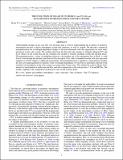Files in this item
The evolution of solar flux from 0.1 nm to 160 μm : quantitative estimates for planetary studies
Item metadata
| dc.contributor.author | Claire, Mark W. | |
| dc.contributor.author | Sheets, John | |
| dc.contributor.author | Cohen, Martin | |
| dc.contributor.author | Ribas, Ignasi | |
| dc.contributor.author | Meadows, Victoria S. | |
| dc.contributor.author | Catling, David C. | |
| dc.date.accessioned | 2016-09-26T10:30:10Z | |
| dc.date.available | 2016-09-26T10:30:10Z | |
| dc.date.issued | 2012-09-06 | |
| dc.identifier | 66186350 | |
| dc.identifier | d906e082-0477-4b77-8f02-d4987b78b8b5 | |
| dc.identifier | 000309052800095 | |
| dc.identifier | 84866138978 | |
| dc.identifier.citation | Claire , M W , Sheets , J , Cohen , M , Ribas , I , Meadows , V S & Catling , D C 2012 , ' The evolution of solar flux from 0.1 nm to 160 μm : quantitative estimates for planetary studies ' , Astrophysical Journal , vol. 757 , no. 1 . https://doi.org/10.1088/0004-637X/757/1/95 | en |
| dc.identifier.issn | 0004-637X | |
| dc.identifier.other | RIS: urn:216CC2AFEC5C594EBE0250D05844767A | |
| dc.identifier.other | ORCID: /0000-0001-9518-089X/work/34103252 | |
| dc.identifier.uri | https://hdl.handle.net/10023/9552 | |
| dc.description.abstract | Understanding changes in the solar flux over geologic time is vital for understanding the evolution of planetary atmospheres because it affects atmospheric escape and chemistry, as well as climate. We describe a numerical parameterization for wavelength-dependent changes to the non-attenuated solar flux appropriate for most times and places in the solar system. We combine data from the Sun and solar analogs to estimate enhanced UV and X-ray fluxes for the young Sun and use standard solar models to estimate changing visible and infrared fluxes. The parameterization, a series of multipliers relative to the modern top of the atmosphere flux at Earth, is valid from 0.1 nm through the infrared, and from 0.6 Gyr through 6.7 Gyr, and is extended from the solar zero-age main sequence to 8.0 Gyr subject to additional uncertainties. The parameterization is applied to a representative modern day flux, providing quantitative estimates of the wavelength dependence of solar flux for paleodates relevant to the evolution of atmospheres in the solar system (or around other G-type stars). We validate the code by Monte Carlo analysis of uncertainties in stellar age and flux, and with comparisons to the solar proxies κ1 Cet and EK Dra. The model is applied to the computation of photolysis rates on the Archean Earth. | |
| dc.format.extent | 1372699 | |
| dc.language.iso | eng | |
| dc.relation.ispartof | Astrophysical Journal | en |
| dc.subject | Planets and satellites: atmospheres | en |
| dc.subject | Stars: solar-type | en |
| dc.subject | Sun: evolution | en |
| dc.subject | Sun: UV radiation | en |
| dc.subject | QC Physics | en |
| dc.subject | QB Astronomy | en |
| dc.subject | SDG 13 - Climate Action | en |
| dc.subject.lcc | QC | en |
| dc.subject.lcc | QB | en |
| dc.title | The evolution of solar flux from 0.1 nm to 160 μm : quantitative estimates for planetary studies | en |
| dc.type | Journal article | en |
| dc.contributor.institution | University of St Andrews. Earth and Environmental Sciences | en |
| dc.contributor.institution | University of St Andrews. St Andrews Isotope Geochemistry | en |
| dc.identifier.doi | https://doi.org/10.1088/0004-637X/757/1/95 | |
| dc.description.status | Peer reviewed | en |
| dc.identifier.url | http://depts.washington.edu/naivpl/content/models/solarflux | en |
This item appears in the following Collection(s)
Items in the St Andrews Research Repository are protected by copyright, with all rights reserved, unless otherwise indicated.

